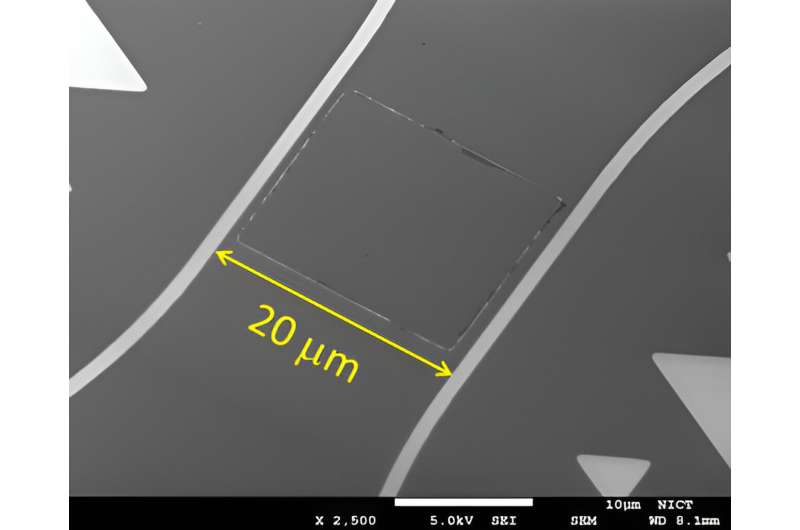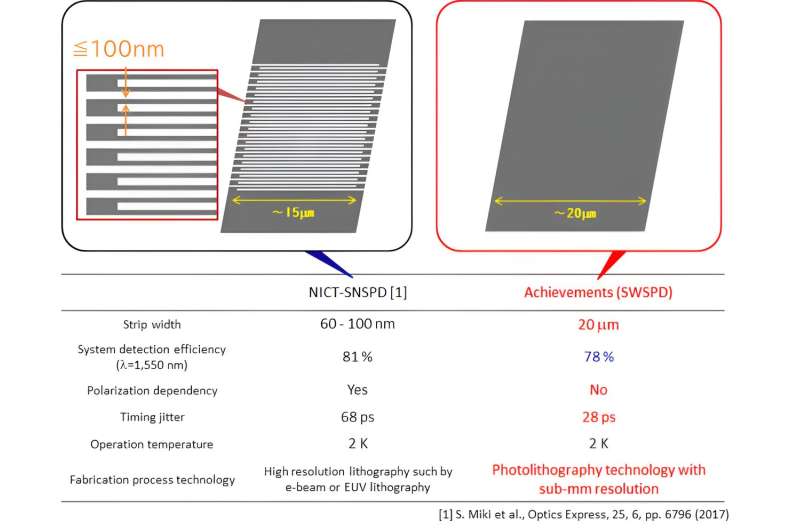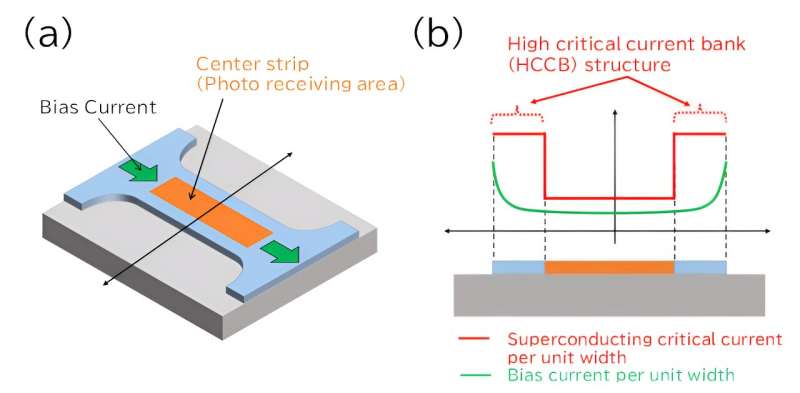This article has been reviewed according to Science X's editorial process and policies. Editors have highlighted the following attributes while ensuring the content's credibility:
fact-checked
proofread
Successful development of the world's first superconducting wide-strip photon detector

Researchers from the National Institute of Information and Communications Technology has invented a novel structure in a superconducting strip photon detector that enables highly efficient photon detection even with a wide strip, and succeeded in developing the world's first Superconducting Wide-Strip Photon Detector (SWSPD).
The strip width of the detector is over 200 times wider than that of the conventional Superconducting NanoStrip Photon Detectors (SNSPDs). This technology can help to solve the problems of low productivity and polarization dependence that exist in conventional SNSPDs. The new SWSPD is expected to be applied into various advanced technologies such as quantum information communication and quantum computers, enabling early social implementation of these advanced technologies.
The work is published in the journal Optica Quantum.
Photon detection technology is a strategic core technology to bring about an innovation in a wide range of advanced technology fields, including quantum information communication and quantum computing, which are currently undergoing intense research and development on a global scale, and also live cell fluorescent observation, deep space optical communication, laser sensing, and more.

The NICT research team has developed a SNSPD with a strip width of 100 nm or less. They have successfully achieved high performance surpassing other photon detectors, and have demonstrated its usefulness by applying it to quantum information communication technology. However, the fabrication of SNSPDs requires the formation of nanostrip structures using advanced nanofabrication technology, which causes variations in detector performance and hinders productivity improvement. In addition, the presence of polarization dependence due to the superconducting nanostrip meandering structure has also limited the application range as a photon detector.
In this work, NICT invented a novel structure called "High Critical Current Bank (HCCB) structure" that enables highly efficient photon detection even if the strip width is widened in the superconducting strip photon detector, and succeeded in developing a SWSPD with a width of 20 micrometers—over 200 times wider than the conventional nanostrip photon detector—and achieved high-performance operation for the first time in the world.

The nanostrip type developed by NICT required the formation of extremely long superconducting nanostrips with a strip width of 100 nm or less in a meandering shape. The wide strip type can now be formed with only single short straight superconducting strip.
This SWSPD does not require nanofabrication technology and can be fabricated by highly productive general-purpose photolithography technology. In addition, since the strip width is wider than the incident light spot irradiated from the optical fiber, it is possible to eliminate the polarization dependence seen in the nanostrip type detector.
As a result of performance evaluation of this detector, the detection efficiency in the telecommunication wavelength band (λ=1,550 nm) measured 78%, which is comparable to the 81% of the nanostrip type. Furthermore, the timing jitter showed better numerical values than the nanostrip type.
This achievement enables the fabrication of photon detectors with higher productivity and superior performance and features compared to the nanostrip type that has been positioned as an indispensable photon detection technology in advanced technology fields such as quantum information communication. Such technology is expected to be applied to various quantum information communication technologies and to be an important basic technology for realizing networked quantum computers promoted in JST Moonshot Goal 6.
In the future, the team will further explore the HCCB structure in the SWSPD, to detect photons with high efficiency not only in the telecommunication wavelength band, but also in a wide wavelength band from the visible to the mid-infrared. Furthermore, they will also try further expansion of the size of the photon receiving area for expanding the applications such as deep space optical communication technology, laser sensing, live cell observation and more.
More information: Masahiro Yabuno et al, Superconducting wide strip photon detector with high critical current bank structure, Optica Quantum (2023). DOI: 10.1364/OPTICAQ.497675
Provided by National Institute of Information and Communications Technology (NICT)





















